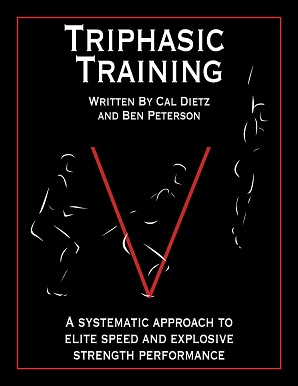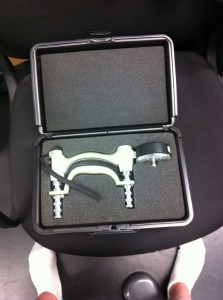(Originally Posted at www.Dragondoor.com)
I must say that I have been using kettlebells within my team’s training program in some capacity during the past 2 years. During that time, we have incorporated the Swing, the Get-Up, and have used the kettlebell for other exercises such as 1-Arm/1-Leg Modified Straight Leg Deadlifts and Slideboard Split Squats. I felt that since I have viewed some really good DVD’s and have read a few books on kettlebells, that I could add kettlebells proficiency. The truth is, even though I can basically add any exercise that I feel is good for my athletes, it wasn’t until I actually became an RKC that I learned that I needed to change a few coaching cues and clean up some technical flaws.
The Swing
I have always believed in performing some kind of Olympic lift variation daily in the off-season. Whether it is a Hang Clean, Hang Snatch, Dumbbell Snatch, or a Push Jerk, we were going to do one of those on a daily basis. There is no question in my mind that there are benefits to Olympic lifting for a hockey player. I think that explosive power development is crucial for the developing young hockey player. The Olympic lifts can help a young player become faster, stronger, while also developing the ability to check more explosively.
The Swing has become a welcome addition to the menu of explosive lifts. The swing is a ballistic lift where we are using maximum power of the posterior chain to accelerate the kettlebell with proper technique. Where I am absolutely certain that the Swing is beneficial for hockey players is the fact that hockey players need to be better at extending their hips- plain and simple. Hockey players spend an enormous amount of time in a flexed spine, hip, knee, and ankle position. Whether they are playing the sport, sitting in their lockers during intermissions, sitting at home, sitting on the plane or the bus, hockey players are always in a shortened position. The Swing helps us get full hip extension.
The Swing can also serve as an evaluation tool for those who really can’t extend their hips all the way through. If we see some players who really can’t seem to get their hips through, we immediately go back to our Glute activation exercises. Although we do spend a good amount of time performing exercises to prevent “Gluteal Amnesia”, the Swing can give us a better indication of who may need those exercises more. With Glute activation exercises and a lot of time spent stretching out our hip flexors; we feel that we can get good results from our Swings.
For the Swing, we can use it as a power exercise where we are doing 2-3 sets of 8-10 reps. We will also use it as a conditioning tool for those who may be injured and may not be necessarily cleared to skate. An example of this may be a player who has sustained an injury to a hand, wrist, or shoulder. We would simply do 1-arm Swings with the good limb.
The Get Up
As a Strength and Conditioning Coach in a team sport setting, I admit that I was hesitant about the Get-up when I first started to learn about it. I viewed it as an exercise that would be too difficult to implement in my coaching situation as it looked like an exercise that seemed too complicated to teach to a large group of athletes. (We have 23 players on our hockey team).
I first learned and practiced the Get-Up at a Perform Better 1 Day Seminar in Los Angeles a few years back. To say that I was humbled by an 8k kettlebell is an understatement. Dr. Mark Cheng was my instructor during the hands-on portion of the seminar. I was coached by him through all of the 7 steps of the Kalos Sthenos method. From my 5 minutes spent with Dr. Cheng, I realized that this was an exercise where proper form was critical. Dr. Cheng was critiquing my every move as I tried to do a Get Up successfully. This was the first time that I realized that our players needed to be doing the Get-Up. I felt that this was a total body exercise that would be beneficial for our team. What I really learned during my learning experience was that performing the Get Up with less than adequate technique really exposes issues such as weakness and tightness to some of the muscles that are involved.
Along with learning from Dr. Cheng at the seminar, another resource that I have found helpful in learning the Turkish Get-up is “Kettlebells From the Ground Up” by the previously mentioned Dr. Mark Cheng, with Gray Cook and Brett Jones. This is a great manual that outlines the 7 steps of the Get-Up in a specific way. One of the quotes from Dr. Cheng in the manual is “Get-Up is an all-purpose strength and stability exercise, as a corrective exercise, and as a movement screen”. I agree with him 100%. An all-purpose strength and stability exercise that is a corrective exercise and a movement screen at the same time? This is an exercise that our players need to get really good at, just like any other exercise in our program.
In our off-season program, we have added our progressions for the Get-Up into our program twice per week. We will do a progression during each of the 3-week phases of the program as part of our workouts on days 1 and 3. We will start the off-season with phase 1 of the Get Up and we will be performing full Get-Ups by the end.
During the in-season phase, we perform core/hip circuits 2-3 times per week. These consist of 6-8 hip and abdominal exercises done twice in a circuit-like fashion. We have added the Get Up progressions to the core circuit. These are done in a progressive format over the course of the season in 5-6 week phases which start with the easiest version in phase 1. By the end of season, we are doing full Get Ups.
The Goblet Squat
The Goblet Squat has become a really good in-season lift for us. During the last few years, I have grown to dislike loading my players’ spines through other double-leg squatting exercises such as the Back Squat and Front Squat. The risk vs. reward benefit of these lifts simply doesn’t make sense to me as a Strength and Conditioning Coach in a professional sport setting. What the Goblet Squat allows us to do is get a really good double-leg strengthening exercise done in a safe manner.
Honestly, I haven’t seen too many Goblet Squats done poorly. However, I can’t honestly say that about Front Squats and Back Squats. With the Goblet Squat, we are coaching our players to sit into the squat by imagining themselves sitting on a curb. I view this exercise as not only as a good strength exercise but also a good hip mobility exercise.
The Overhead Press
Developing shoulder strength and stability is an absolute must in a strength and conditioning program for hockey. With the addition of the Get Up, the Overhead Press has been another great addition to the program. In fact, I think that the kettlebell press is superior to the dumbbell press. It just feels like a more natural movement pattern. When you focus on using tension to provide a better base of support to press from, the press is much more than a shoulder exercise.
We will progress from a half-kneel position to a kneeling position, to a lunge position, and then to a standing position. This is done so that our players can help achieve strength in these positions and help correct some deficiencies from their Functional Movement Screen Scores.
My thoughts on the Snatch
Personally, in my own training, I really love the kettlebell snatch as a conditioning tool. I really think that this would be a great tool for hockey players as well because we are getting more high velocity hip extension over and over again. However, what I don’t like about the snatch is that it really beats up the hands. I think back to my RKC prep and the fact that I really tore my hands apart when I was doing my high rep range snatches. I can’t afford to have my players hurt their hands during the training process. If a player has learned how to do them properly and takes care of his hands properly, I wouldn’t hesitate at all. However, until then, I will save the Snatch for my own training.










